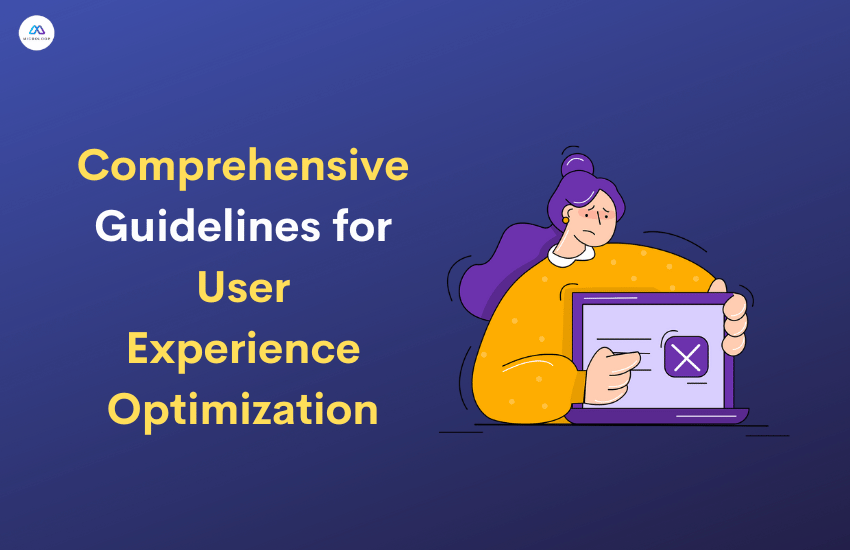
Close


The industry's shift towards optimize user experience or user experience optimization has made it increasingly vital for users to have the best website navigation experience.
With over a decade in the industry, Microloop IT Solution, USA, consistently ensures the delivery of top-tier UI/UX services to clients. They optimize solutions based on their expertise and the best interest of their clients.
In this blog, we will delve into UX optimization, covering best practices to help you learn how to maintain a seamless user experience throughout your journey.
Let's get started!
User experience optimization is understanding how users interact with your app and tapping on the opportunities to enhance the existing user experience.
It will help you ensure that users become more engaged, better understand your product, and are more likely to return.
It involves user engagement patterns and the types of devices they use to access your app.
Collecting and analyzing data gives us insights into areas of the user journey that need improvement.
For example, If users are facing any problem while signing the form, optimizing this process can reduce frustration and increase engagement.
Identifying UX issues can be a daunting task for managers and team members. There are a few ways to analyze the problems achieved through various methods, such as conducting UX audits, usability testing, and behavior data.
Usability testing benefits those intending to test their website before its public launch, enabling proactive changes for a seamless launch. A UX audit assists in assessing the current state of the product/service to identify usability problems or areas for enhanced user experiences.
Behavioural data collection involves gathering insights into how users engage with the product identifying valuable features and confusing areas.
Prioritizing UX is critical for enhancing the performance of your app or website. This involves significant aspects like user interface design, usability, and overall user flow.
To prioritize the changes effectively, research and gather data to make informed decisions on improvements for a better user experience.
After identifying necessary UX changes, thorough testing is essential to evaluate their impact on customer experience before implementing them widely. This ensures overall user satisfaction with the product.
This will allow you to evaluate your changes in improving customer experience before implementing them on a large scale. It ensures overall user satisfaction with the product.
Improving user experience requires understanding the user journey and identifying potential areas of improvement. This step demands conducting surveys, customer interviews, or evaluating usage data.
Once areas for improvement are identified, the product team designs and tests new features or UI/UX changes.
The last step is conducting tests like UAT A/B tests, which help identify issues that automated testing might miss.
Post-implementation of UX optimization, measuring success through several metrics becomes crucial. These metrics assess UX improvement's effectiveness and value, guiding future decisions and demonstrating ROI.
Critical monitoring metrics include user engagement metrics like retention rates and session lengths. Higher retention rates indicate user-perceived value and ease of use, while longer sessions suggest an engaging app that adds value to the user experience.
Adopting the best practices is crucial to ensure a positive user experience. Let's explore them step by step:
Firstly, ensure that your website or mobile app's design prioritizes ease of use and navigation, catering to users seeking information, making purchases, or accessing services.
The ultimate objective should be to ensure users are satisfied and confident, which can lead to users leaving and not visiting again.
Secondly, optimizing user experience involves directly and concisely ensuring the language. Avoid using jargon and terms that the general public may not understand.
Remember, clear and straightforward communication enhances user engagement.
Thirdly, besides delivering a positive user experience, ensure accessible customer service options. This includes providing contact information such as phone numbers, an online chat system, or a FAQ section. These avenues offer users assistance and support when needed.
If you are searching to improve the user experience on your website or aim to retain customers, consider conducting UX optimization. Let's explore a few reasons why or how your website can benefit from UX optimization:
A higher rate signifies the percentage of visitors who take desired actions on your website, such as signing up for a newsletter, purchasing, or filling out an embedded form. This means that improving user experience can increase conversion rates by making it easier and more enticing for users to complete their actions.
User experience optimization focuses on how end users interact with and perceive your website or an app. Improving factors such as ease of navigation, loading speed, accessibility, and overall experience enhances UX, catering to user needs and preferences for a seamless user experience.
A website with a good reputation offers a better user experience. Positive user experience leads to return visits and recommendations, establishing trust and credibility. This significantly impacts conversion rates and user retention.
The bounce rate is % of visitors who will exit the website or app immediately after navigating to it. High bounce rates indicate UX, site speed, or content relevance issues.
Working on this factor will help you reduce bounce rates by providing engaging content, straightforward navigation, and a visually appealing layout. This encourages visitors to explore further, optimizing the end-user experience.
We hope the blog concludes that optimizing for user experience on your website or app requires a clear and precise design and an engaging interface that attracts users and minimizes the bounce rate.
Many companies offer services for optimizing user experience.
What sets Microloop IT Solution, USA, different is the expert team. They possess and share their expertise in ensuring that website UX is designed for a website to optimize user experience for the long term.